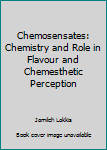Chemosensates: Chemistry and Role in Flavour and Chemesthetic Perception
Trigeminal chemosensates represent a novel class of ingredients that have gained tremendous interest from formulators in the food and consumer products' industries as well as those in neuroscience research groups. This interest is driven by two main factors: The chemosensates' ability to provide unique sensory attributes such as cooling, warming, tingle, etc, and the recent findings of a strong correlation between the chemistry of those ingredients and underlying chemosensory responses such as nerve-activated pain and other neuronal systems responsible for signal transduction. Trigeminal Chemosensates have become essential constituents of flavor and fragrance compositions as well as those of a variety of consumer products. Cooling and warming agents are the two main classes of chemosensates currently incorporated into such compositions. Cooling sensates, for example, are added to lozenges, chewing gums, beverages, ice creams, tobacco, shaving creams and oral care products to signal refreshment, while warming agents are used to provide soothing relief. This book is the first to document the unique chemistry of sensates, highlight their functionality and explore their use in one comprehensive volume. It also provides an in-depth discussion on various theories of the modes of action of chemosensates as well as their underlying biochemical and genetic basis. The book will first review traditional "natural" sensates such as menthol, capsaicin, jambu, and ginger extracts as well as synthetic sensates such as icilin, carboxamides and their derivatives. It will present insights into the physiological and molecular requirements for their functionality, the role of molecular parameters such as chemical structures, isomeric conformations and structural modifications of specific molecular moieties. Techniques for characterizing sensate compounds and their ability to modulate the activity of specific clusters of neurons will be highlighted. Examples of such techniques include taste dilution analysis, structure-function analysis, electrophysiological and calcium-imaging as well as other novel approaches. Challenges in the effective utilization of sensates in various applications will be presented. The impact of physiological barriers for sensates permation through the skin, trigerminal nerve and oral mucosa will be presented. Potential means for enhancing their effectiveness will be discussed via proposing delivery vehicles that can provide long lasting impact. Distinction will be made between those factors that are related to the senates' properties such as solubility, chemical stability, evaporative cooling, time of exposure, synergistic effects of different classes of sensates and so on, and those related tot he neural source of enhancement such as role of the microenvironment and the activity of engoeneous activators of modulators of the nerve fibers. The book will conclude by highlighting recent innovations in manufacturing procedures of sensates as well as their future potential applications. A discussion of marketing perspectives and economical implications of using these ingredients in various applications will be included.
Format:Hardcover
Language:English
ISBN:0123743346
ISBN13:9780123743343
Release Date:March 2020
Publisher:Academic Press
Length:312 Pages
Weight:1.74 lbs.
Dimensions:7.5" x 9.3"
Customer Reviews
0 rating





